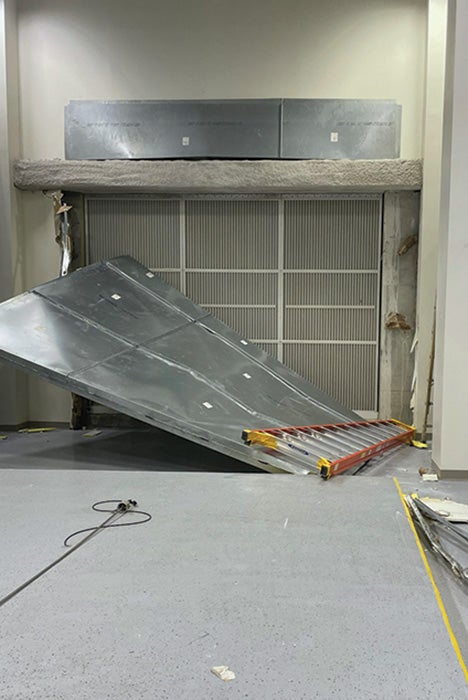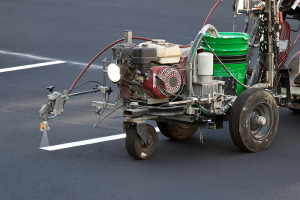Florida system shares lessons learned from Hurricane Ian

Category 4 winds during Hurricane Ian damaged signage on the Golisano Children’s Hospital of Southwest Florida.
PhotoS courtesy of Lee Health
The facilities staff at Lee Health in southwest Florida spent days bracing for the arrival of Hurricane Ian. The National Hurricane Center was predicting Ian would cause catastrophic storm surge and high winds as it made landfall as a Category 4 hurricane in Florida.
When it came ashore west of Fort Myers in Cayo Costa, Fla., on Sept. 28, 2022, with wind speeds of over 150 mph — skirting just below Category 5 wind speeds — Ian became among the strongest hurricanes ever to hit the state.
Lee Health was prepared. Like many institutions across Florida, the health system had made significant strides in strengthening its resiliency. In fact, the 25 generators supporting the five Lee Health hospitals across the hurricane’s cone would operate without a hitch for more than 80 hours as Ian moved inland.
“In the past, it’s always been about power, power, power,” says Rod Allen, system director of plant operations at Lee Health. “The health care [field] has pretty well gotten power in hand. Most health care facilities are equipped to deal with power loss for a long period of time. What they may not be able to sustain is long-term water outage.”
It was the loss of the water utility that would throw Lee Health its biggest challenge and force the health system to expand its disaster preparedness planning in the wake of this storm.
Storm preparation
“Where we are, we’re used to hurricanes coming our way,” Allen says. So, when forecasts consistently showed Lee Health within the cone of the upcoming storm, the facilities team went to work.

As the storm surge rose during Hurricane Ian, water quickly overburdened the storm sewers and filled parking lots at HealthPark Medical Center.
PhotoS courtesy of Lee Health
Ten days prior to landfall, the team began assessing its fuel situation, moving in supplies, clearing storm parking lot and rooftop drainage systems, and staging materials that would be needed to speed the repair of broken windows, water leaks and other problems. Construction work was shut down, dumpsters emptied and loose materials securely stowed.
The team also reached out to key business partners in the community, ensuring up-to-date contact information. PowerSecure Inc., a Durham, N.C.-based distributed energy company that provides storm resiliency and response services for Lee Health, arrived to test generators. “We put them under load to make sure everything worked correctly in anticipation of the storm, and then topped off all of the fuel and diesel exhaust fluid (DEF),” says Adam Dutka, who is vice president of sales for health care and life sciences at PowerSecure.
Three days out, as it became clear Hurricane Ian would skirt the coast in a worst-case scenario for the region, the team began to shutter openings, leaving the main entrance areas open until the last possible moment.
“We were prepared for fuel. All of our systems were ready to go for backup water supply. As we started into the storm, things were going well,” Allen says.
Then came the curveball. As Ian moved onshore, it pulverized Lee County, leaving water infrastructure as one of the early casualties. Until the water receded, none of the municipal water utilities serving Lee Health’s largest campus, HealthPark Medical Center or the connected Golisano Children’s Hospital, were able to get close enough to the valves that would allow them to recharge the system and get water to the campus.
“We had prepared for it, we had backup plans for it, but we didn’t have the process in place for supporting water loss for days at a time,” Allen says. “That’s where it put us into a scramble mode.”
Storm-surge management
In nearby Fort Myers Beach, the storm surge rose to levels as high as 15 feet as Hurricane Ian touched ground. As the water rose, it quickly overburdened storm sewers, filled parking lots and moved dangerously close to HealthPark’s first floor. The sanitary sewers, however, were still functional. With a call warning the local utility of the plan, the HealthPark facilities team used pumps to divert floodwaters surrounding the building into the sanitary sewers, preventing any water infiltration.
As employees worked to keep stormwater out, other members of the team searched for a way to get water in to maintain cooling towers and boiler operations. Without the water utility, HealthPark shifted to its first backup plan.
“In Florida, most properties have retention ponds to control stormwater runoff,” Allen says. “We had taken that into consideration for supplying water during an emergency. We put provisions in so that each facility could pump water from the retention pond into our cooling towers. Working with our chemical vendor, we increased the chemical dosage to control bacteria, hitting it really hard with biocide.”
Due to this switch, the cooling towers never lost power. However, the facilities team quickly learned that the 10,000-gallon fresh water feed allocated for emergency use to support boiler operations would not last very long. When the fresh water ran out during the storm, it shut down the facility’s sterilization programs and threatened building air conditioning.
To control relative humidity (RH) in the building, facilities employees were assigned to monitor the dew points outside and throughout key areas of the medical center. Adjustments were made as needed to the air-handling systems to maintain a consistent 50% to 55% RH.
The loss of water also forced HealthPark into fire watch mode. Life safety systems became the facilities team’s first priority, and where they directed first conversations with the local utility. “They worked some miracles for us,” Allen says. “They rerouted a lot of lines and valving to get water back to our hospitals fairly quickly.”
Through temporary lines, the utility was able to return around 20 pounds per square inch (psi) to the hospital. With the support of their trade partner, the facilities team calculated that 20 psi would be sufficient to ensure 100% coverage from fire pumps.
“That gave our fire marshals a certain comfort level,” Allen says. “It helps to know that, in the future, the number to maintain is 20 psi.” Bringing fire protection back online also freed up staff to redirect to other critical maintenance issues.
Power system monitoring
That redirected staff was dearly needed, as power systems soon required monitoring.
PowerSecure was monitoring generators remotely to alert Lee Health’s facilities directors of potential problems. “When the storm hit, we saw engines come online. We were watching fuel levels, DEF levels and temperatures, and making sure that there weren’t any issues,” Dutka says. “We called the customer to let them know what we were observing, which freed them up to not physically sit there.”

Wall damage in the generator room in the central energy plant at Lee Health Coconut Point outpatient center.
Photos courtesy of Lee Health
When a generator wall blew out at Lee Health Coconut Point, a 163,000-square-foot outpatient center with a free-standing emergency department, PowerSecure was available to answer questions remotely. When a low coolant alarm went off on a generator at Coconut Point, the PowerSecure team alerted Lee Health staff immediately.
“They were operating at N+2 and were never in jeopardy of losing critical power to the facility,” Dutka says. Yet a service technician from PowerSecure was the earliest contractor to move on-site to ensure the remaining generators operated as expected.
This back-and-forth communication provided critical support, but it didn’t last. During the storm, nearly 1,100 wireless cell towers serving the state of Florida lost power. Without that communication, PowerSecure suddenly lost vision into Lee Health’s power systems. Lee Health staff were assigned to monitor equipment across the entire system as a precautionary measure.
While the cell utility’s outage was a stroke of bad luck, good planning ensured Lee Health had no additional engine issues throughout the rest of the storm.
Dan Chisholm Sr., CHEPP, president of MGI Consulting Inc., an Orlando, Fla.-based provider of emergency power system design, construction and training, puts that into perspective. “They have five hospitals that took a direct hit, and they made it through with 80-plus hours of continuous running on those generators, and never lost power,” he says. “We cannot say enough good things about Lee Health.”
Wading through damage
As the storm passed, Lee Health had another stroke of luck. The days following the storm were comparatively dry and cool, making it easier to maintain a consistent RH until the boilers regained operation. The system had plenty of bottled water on hand and flushing plans in place, and all seemed secure. Yet without clean water coming in, state authorities having jurisdiction were concerned that patient care could still be compromised.
“We quickly worked with the state of Florida to bring in water trucks and tied those into our pump systems. That temporary water bought us a little bit of time,” Allen says. It was enough time for the utility to lay out temporary lines to reconnect HealthPark to the local water system until more lasting repairs could be made.
With the water challenges in hand, repair work could begin on other systems impacted by the storm. Within hours of the hurricane’s end, Lee Health’s trade partners arrived on-site.
“The winds really hadn’t even died down and contractors were there putting temporary patches on some roof areas that had peeled back, areas that we had already slated for replacement this year and just hadn’t gotten to yet,” Allen says.

Roofing damage during Hurricane Ian was limited to those facilities, like Lee Memorial Hospital pictured here, where Lee Health had already scheduled roof replacements for later this year.
Photos courtesy of Lee Health
In addition to some roofing damage, an exhaust fan had been blown from the HealthPark Medical Center rooftop. “One of our challenges had been maintaining negative pressure in our airborne infection isolation rooms when some of those fans decided to fly away,” Allen says. “Thankfully, we had spares in our stock.”
HealthPark’s on-staff industrial hygienist made the rounds with the facilities team to assess minor damage from water that had been driven in through the window weep system by the heavy winds. Drywall was replaced in a few rooms as a precaution against mold.
Only one building suffered significant structural damage. A medical office building housing Lee Health’s rehabilitation hospital, a facility tied to Lee Memorial Hospital, suffered a wall failure in its elevator room. The failure damaged three of the building’s four elevators and put the building into crisis mode, Allen says.
The in-house construction department, with support from structural consultant partners, put in long hours to reinforce and then rebuild the walls. Technicians from Otis, which holds the service contract on the building, and Thyssenkrupp, whose equipment was installed, also moved quickly on-site to support the repairs, focusing first on the least damaged of the three elevators.

Damage to the elevator room in the medical office building housing Lee Health’s rehabilitation hospital disabled the bank of elevators and required $1 million in repairs.
Photos courtesy of Lee Health
“Our elevator consultant said, ‘I give you a 20% chance that you’ll be able to get that elevator running,’” Allen says. “We were able to salvage parts from some elevator equipment and pull parts from other buildings that were either shut down or had spare parts on hand.” Within weeks, the facility had two working elevators, returning the facility to operable status.
Post-storm debriefing
A week after the storm, power was still being brought online across southern Florida. A month after the storm, water service was still being restored across Fort Myers. As communities struggled to rebuild, Lee Health was making new plans to ensure the populations it serves won’t face any future interruptions to critical care services.
“As a system, we are very fortunate to have a board of directors and chief executives who really know the value of investing in the infrastructure of our buildings,” Allen says. “We proactively replace roofs. We weather-test everything to make sure that it’s going to hold up. In the small scheme of things, it may cost a little bit more, but in the larger scheme, it’s pennies for the protection that it gives you.”
Training proved to be another critical investment. “All emergency power supply system personnel were trained by MGI and had a Certified Healthcare Emergency Power Professional certification. They knew what to do and they practiced these plans on a monthly basis, as required by 42 CFR 482.15, Condition of Participation: Emergency Preparedness, subsections (d) and (e) [which reference the National Fire Protection Association’s NFPA 99, Health Care Facilities Code, and NFPA 110, Standard for Emergency and Standby Power Systems],” Chisholm says. “We had a Plan B in case of any emergency power failures, and a Plan C if Plan B failed.”
Now, the system is making plans to reduce its reliance on outside utilities during future disasters. The first priority has been to work with each municipality to install on-site backup wells for all Lee Health hospitals.
“We have one building with a backup well, and it was utilized during the storm to keep our cooling on, but it really wasn’t large enough to supply all the building needs. Now we’re working with municipalities to put in appropriately sized wells at each facility,” Allen says. He advises other health care facilities in coastal communities to explore the feasibility of adding well water as a backup. For Lee Health, wells will be a standard feature of any future facility design.
Yet if there’s one thing Allen has learned from this experience, it’s that it’s not enough to have a Plan B. That’s why he’s also exploring other potential alternative sources of emergency water.
“Can we utilize our sprinkling systems and those pumps to fill up cooling towers and keep cooling online? It might be as simple as running some emergency power over to the pump house that runs the pump, or it may be as complex as installing 150-foot wells and tying into our domestic water system with backflow prevention and all the apparatuses that are required to do that,” he says.
The health system is also looking to expand its water management plan to address water loss management. “Most plans are around what do you do once you get water back. Ours are going to go more in depth of how we’re going to manage long-term outages,” Allen says.
Finally, Allen advises other facilities professionals to map their water lines, especially where they come into buildings. “Do you have trees going over the top of those? I would proactively trim them down. If a tree comes up, it’s liable to bring your water line with it.”
In terms of power, PowerSecure is exploring more resilient communication options. “We’re looking at satellite communication and what it would look like to not rely on the local cell towers to support communication,” Dutka says. While a potentially more expensive option than a cell tower, events like this demonstrate the critical need for health systems to reduce reliance on outside infrastructure.
As Allen puts it, “You’ve got to think like you’re on an island and nobody’s coming to help you. You have got to make sure you can help yourself.”
Resiliency begins with preparation
As southwest Florida-based Lee Health learned during Hurricane Ian, there’s no preparing for the unexpected — but investing in proactive maintenance and having multiple backup plans in place can make it significantly easier to weather natural disasters.
“Just because a hospital is fully compliant with the standards doesn’t necessarily mean they’re bulletproof,” says Dan Chisholm Sr., CHEPP, president of MGI Consulting Inc., an Orlando, Fla.-based provider of emergency power system design, construction and training. “The secret to a hospital going through a disaster without any problems is preparedness. You can have the best equipment and the best facility designs, but if you haven’t worked up a Plan B, and a Plan C in case B tanks on you, you’re out of luck.”
Not every Florida hospital was as fortunate as Lee Health’s HealthPark Medical Center. “I was on a call with a health system in the same area [as Lee Health] that lost a hospital because their generators didn’t start,” says Adam Dutka, vice president of sales for health care and life sciences at PowerSecure Inc., Durham, N.C. “I told them we’d get our service technicians in there to take a look, see why they didn’t start, then figure out a plan to get them up to the same level as their peers in the area.”
Dutka says that these issues are often about preventive maintenance. For systems impacted by Hurricane Ian, that maintenance cycle begins again post-storm with oil and cooling samples to make sure there isn’t anything wrong with generators coming off of 80 hours of operation. “Implementing the lessons learned is the biggest thing,” Dutka adds.
Acting rapidly on lessons learned post-storm is a critical step in building up resiliency against future disasters, Chisholm says. “The longer the time after a catastrophic event, the shorter memories become — and the less attention is given to increasing budgets for improvements. If you don’t get into the boardroom with a plan early after the storm, you can just about forget it,” he says.
Megan Headley is a freelance writer and regular Health Facilities Management contributor based in Fredericksburg, Va.




